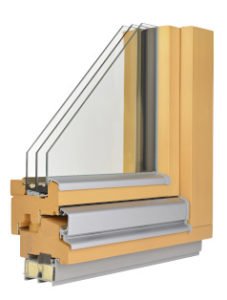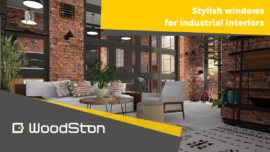
Double and triple glazed windows. Which solution to choose?
Two panes of glass are better than three? In theory yes, in practice the issue is much more complicated. Although a triple-glazed (double-chambered) window package will indeed be better in justified cases, only some people will benefit from the advantages of such a window. A lot depends on the heat transfer coefficient of the whole house and the energy-saving solutions applied.
Double and triple glazed windows – the differences

Figure 1 Three-pane, double-glazed window in a wooden profile
The standard in window joinery are double-glazed (single chamber) windows, made of two panes of glass between which there is an insulating chamber filled with gas – often argon or krypton.
It is gas that has insulating properties, and to a large extent the heat transfer coefficient of glazing depends on it. In combination with a frame of appropriate construction, such a window is sufficient to maintain the heat transfer coefficient of the entire window at a level below (and often much lower than) 1.1 W/(m2-K) at a calculation temperature ≥ 16°C, i.e. for heated rooms.
For the glazing package alone, the Ug value is typically 0.5-0.6 W/(m2-K) for argon and 0.3 W/(m2-K) for krypton. So windows with krypton are warmer. At the same time, it should be remembered that the glazing package itself is not everything; the construction of the frame and the way the panes are fixed in the window are also of great importance.
The triple-glazed (double-glazed) package is characterised by a lower heat transfer coefficient, even below 0.6 W/(m2-K).
This is due to the use of two gas-filled chambers for even better insulation and wider frames for better performance. An additional advantage of triple-glazed packages is their greater resistance to burglary – it is more difficult to break through three layers of reinforced glass.
However, this solution is much more expensive than the standard one, and it will not bring any benefits in poorly insulated rooms. If the window has a low Uw, but the walls and ceiling are leaky with numerous thermal bridges, the window will not contribute to the insulation of the flat. In that case it will be an unnecessary expense.
Not only the glazing package (we distinguish between single-chamber and double-chamber packages)

Figure 2 Double-glazed, single-chamber window in a steel profile
Special profiles which reduce heat loss are also used in energy-efficient windows. Currently wooden window frames with 68mm and 72mm profiles, as well as those made of 3,4,5 and 6-chamber sections (this applies to PVC windows) predominate on the market.
There are also profiles with more chambers and a special design. However, a greater number of chambers does not always translate directly into heat transmission, as the smaller the chambers, the lower their effectiveness, and with an increase in the number of chambers comes an increase in frame thickness.
Another important factor is how the window is installed. Incorrect installation may result in thermal bridges and leaks, which will lower the heat transfer coefficient.
Therefore, in energy-efficient and passive houses, special care must be taken to ensure that the frames are installed correctly – regardless of whether they are made of wood, steel, aluminium or plastic.
Triple-glazed window in a passive house – the best choice
In an ordinary, well-insulated house, good double-glazed windows (i.e. single-chambered) are sufficient. There is no point in overpaying for a solution, the advantages of which will not be used anyway.
Of course, there is nothing to prevent people from installing one, but residents will not notice any significant change compared to high-class single-chamber windows.
Triple-glazed (double chambered) windows are not so much recommended as a necessity in houses constructed in such a way as to minimise the consumption of energy needed to heat and cool the interior. Thanks to a significantly reduced heat transfer coefficient, energy losses will be much smaller.
These models also have a favourable solar energy transmittance coefficient, which is a characteristic parameter for active windows. They extract solar energy to heat the interior of the room, but do not cause excessive overheating.
Sometimes the choice of the right solution may not be obvious. We encourage you to arrange a consultation with a WoodSton specialist. We will help you choose and suggest which solution will be best for your home and budget. When preparing estimates, we always take into account your opinion and consider various options depending on the assessment of these needs.





